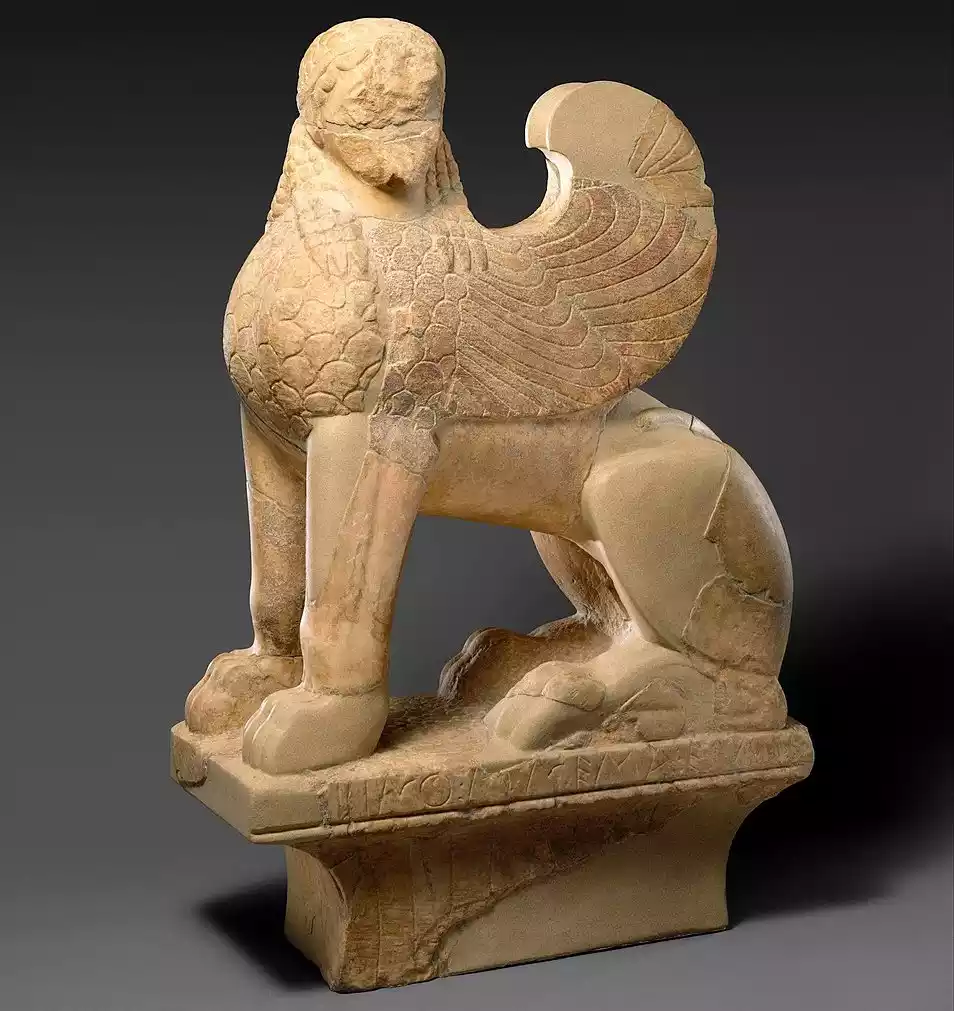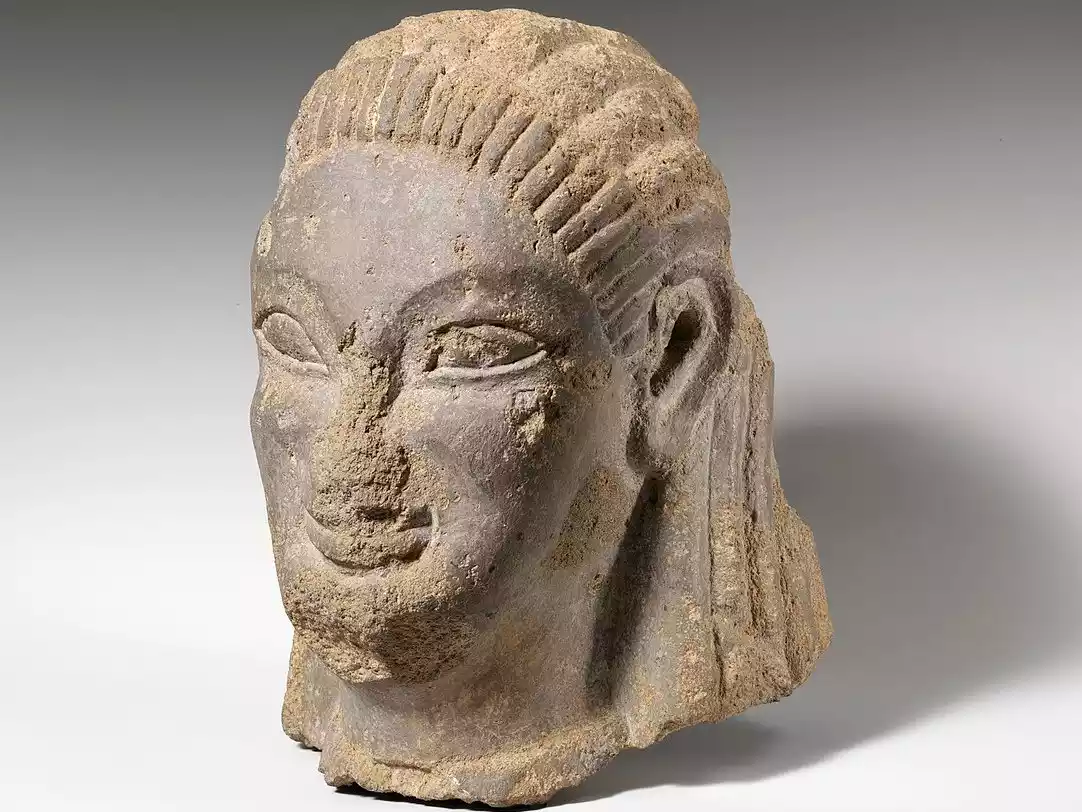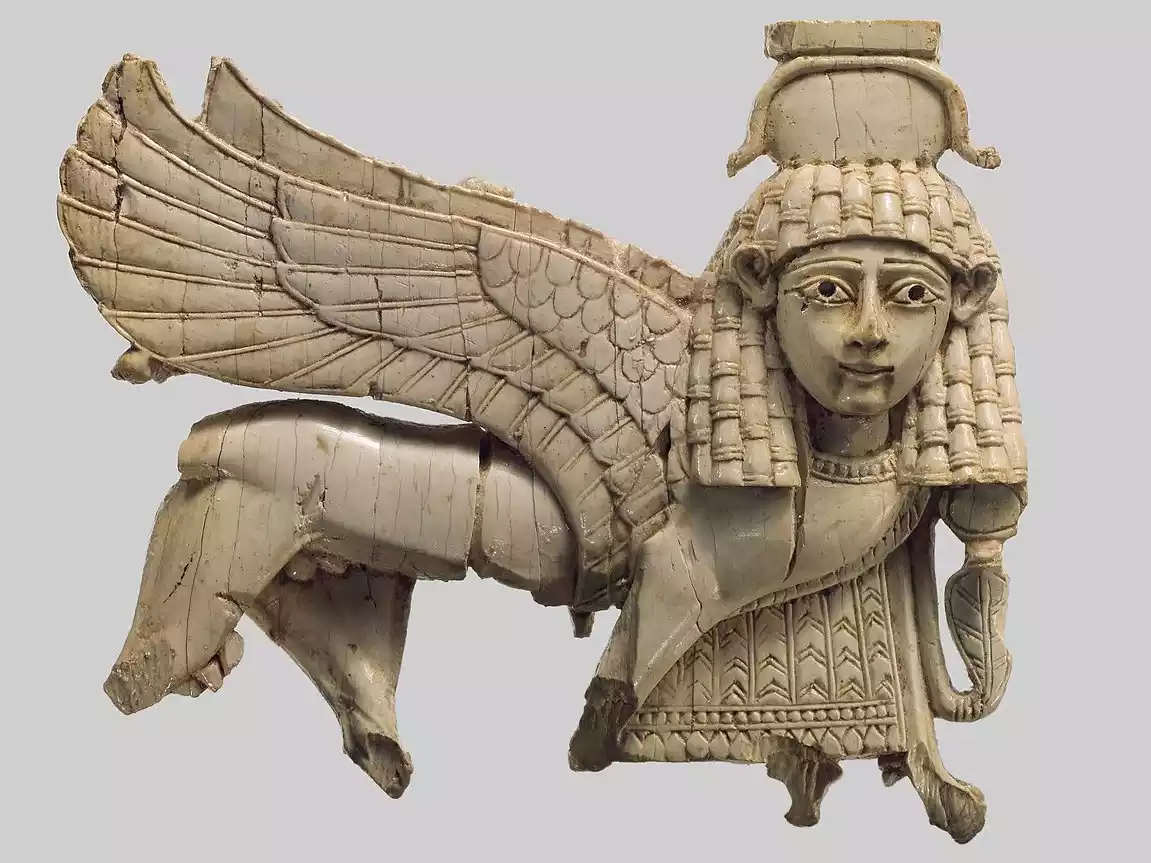
Archaic Sphinx made of Pentelic marble, ca. 570 BC. Found in Spata, Attica, and served as the crowning of a funerary stele. Athens, National Archaeological Museum, no. 28.
In the intricate narratives of Greek mythology, few figures ignite the imagination and challenge the mind as much as the Sphinx. This enigmatic creature, often depicted with the body of a lion, the wings of a large bird, and the head of a woman, stands as a symbol of mystery, danger, and wisdom gained through trials. The Sphinx is not merely a monster of myths but a complex entity intertwined with the fate of the city of Thebes and the tragic story of Oedipus. Its origin is presented in various versions by ancient writers, with Hesiod mentioning her as the daughter of Orthrus (a monstrous dog) and Chimera (another hybrid creature), reinforcing her monstrous nature (Liddell, Scott). According to the myth, the Sphinx settled on a mountain outside Thebes as a divine punishment for some ancient wrongdoing that had occurred in the city. There, she posed a famous riddle to every passerby, and those who failed to solve it met a terrible death at her claws. Her presence sowed terror and despair until the arrival of Oedipus, the fateful hero who would manage to decipher her riddle, forever changing the course of his own life and that of the city. The story of the Sphinx and Oedipus is one of the most timeless threshold myths, where the hero is called to cross a boundary into the unknown (Renger).
The Origin and Nature of the Sphinx
The form of the Sphinx, as we know it from Greek religion and mythology, is a fascinating amalgam of different cultural influences, although it has its own unique characteristics. While the image of a creature with the body of a lion and a human head is already found in ancient Egypt (where it was usually a male form and guardian of sacred places), the Greek Sphinx differs significantly. It is female, often winged, and is inextricably linked to the concept of the riddle and the fatal challenge. Its genealogy, as mentioned earlier, places it among the monsters born from primordial deities or other mythical creatures, underscoring its otherworldly and dangerous character. Some sources refer to it as the daughter of Typhon and Echidna, parents of many monsters in Greek mythology, reinforcing its image as a force hostile to order and human civilization. Its description as a being with a “slender waist like a wasp” in ancient texts adds an additional, particular detail to its depiction (Liddell, Scott). Its appearance outside Thebes was not coincidental but was often associated with divine wrath, possibly of Hera or Ares, who wished to punish the city for the sins of the royal house of the Labdacids. Thus, the Sphinx transforms from a mere monster into an instrument of divine justice, albeit merciless.
The Terrible Riddle and Terror in Thebes
The Sphinx’s actions centered on posing a single riddle to travelers approaching Thebes. Sitting on a height (often referred to as Mount Phikion or Sphinxion), she blocked access to the city. The riddle, as transmitted by most sources, was: “What creature walks on four legs in the morning, two legs at noon, and three legs in the evening?” (What being has one voice and becomes four-footed, two-footed, and three-footed?). The inability to answer meant certain death, as the Sphinx would devour her victims. Thebes was plunged into despair. The number of victims increased, and terror paralyzed the city. King Creon, who had taken power after the death of Laius (whom, unbeknownst to him, Oedipus himself had killed), found himself in a deadlock. In a desperate act, he promised the hand of his sister, Jocasta (the widow of Laius), and the throne of Thebes to whoever could solve the riddle and free the city from the plague of the Sphinx. Many brave, yet reckless, tried their luck, only to be added to the grim list of the monster’s victims. The atmosphere was heavy, and the future of Thebes appeared bleak, until the arrival of a foreign traveler, Oedipus.

Marble Sphinx on an Attic capital with a curved wave (cavetto). Archaic work, ca. 580–575 BC. Possibly the crowning of a funerary monument.
Oedipus Confronts Fate and the Sphinx
Oedipus, upon arriving in Thebes, was already marked by fate, although he did not fully know it. Having left Corinth to escape a terrible prophecy that said he would kill his father and marry his mother, he found himself unwittingly on the path to its fulfillment. At the crossroads of three roads, he had already committed patricide, killing Laius in a scuffle. Arriving at the outskirts of Thebes and learning about the Sphinx and the reward offered, he decided to confront the monster. This encounter is a pivotal moment in the myth of Oedipus (Malanda Dem, Dimbu). The Sphinx posed her well-known riddle. Oedipus, possessing acumen and wisdom, immediately understood the solution: man. At the beginning of his life, he crawls (four-footed), in adulthood, he walks on two legs (two-footed), and in old age, he uses a cane for support (three-footed). The correct answer signified the defeat of the Sphinx. According to most versions of the myth, the monster, humiliated and defeated, fell from the rock where she stood and was killed. Thebes was saved, and Oedipus was declared a hero.
The Irony of Victory
The victory over the Sphinx, although it freed Thebes from terror, marked the beginning of Oedipus’s tragedy. As a reward, he married Jocasta, his own mother, and ascended to the throne, thus fulfilling the second, more horrific part of the prophecy. The Sphinx, with her riddle concerning human nature and the course of life, inadvertently acted as a catalyst for the revelation of Oedipus’s tragic truth. His ability to solve the Sphinx’s riddle demonstrated his wisdom, but his ignorance of his true identity and actions led him to destruction. The Sphinx, this mythical monster, thus becomes a symbol of the dual nature of knowledge: it can liberate but also lead to suffering when revealing truths that one is not ready to face (Barracuda). The story of Oedipus, as masterfully depicted in Sophocles’ tragedy, Oedipus Tyrannus, deeply explores themes of fate, free will, truth, and ignorance, with the shadow of the Sphinx looming over the events (Sophokles).

Head of Sphinx or Siren made of tuff (volcanic rock). Etruscan work, possibly from Vulci, ca. 550–525 BC. New York, Metropolitan Museum of Art
The Symbolic Dimension of the Sphinx
Beyond its literal presence in the myth, the Sphinx carries rich symbolism that has engaged thinkers and artists throughout the ages. It is often interpreted as:
- Symbol of the Unknown and Mystery: Its hybrid nature and riddle represent the unknown forces, hidden meanings, and challenges posed by life and fate. Confronting it requires courage and mental clarity.
- Symbol of Destructive Knowledge: As in the case of Oedipus, the knowledge that the Sphinx offers or provokes can be dangerous. Solving the riddle saved Thebes, but led Oedipus to his personal tragedy, revealing the incestuous relationship and patricide.
- Guardian of Thresholds: Positioned at the boundaries of the city, the Sphinx acts as a guardian of a threshold, both geographical and symbolic. To pass, one must prove their worth by solving the riddle concerning the essence of human existence.
- Psychoanalytic Interpretation: In psychoanalysis, particularly by Freud and his followers, the Sphinx and the myth of Oedipus are linked to the Oedipus complex, the unconscious desires and fears related to parental figures. The Sphinx may symbolize the terrifying, enigmatic side of the maternal figure or the challenge of maturation. (An interesting perspective for further exploration: psychoanalysis myth Sphinx).
The complexity of these symbolisms explains why the form of the Sphinx continues to inspire and provoke thought, serving as a timeless archetype in art, literature, and philosophy.

Perforated plaque made of ivory with a striding Sphinx. Assyrian work, ca. 9th–8th century BC, a sample of art from the Ancient Near East. New York, Metropolitan Museum of Art, no. 64.37.1.
Different Interpretations & Critical Assessment
The interpretation of the myth of the Sphinx and Oedipus is not univocal and has been the subject of study from many different perspectives. Researchers such as Claude Lévi-Strauss approached the myth through structural analysis, focusing on the binary oppositions and social structures it reflects. Others, following the psychoanalytic tradition of Sigmund Freud or Carl Jung, see in the Sphinx archetypal forms and symbols of the unconscious, such as the terrifying mother or the challenge of individuation. Philologists and historians, such as Karl Kerényi, may focus on the religious and ritual roots of the myth, linking it to ancient cults and beliefs. There are, therefore, multiple readings that illuminate different aspects of this rich myth.
Epilogue
The Sphinx, the enigmatic monster of Thebes, remains one of the most captivating and multifaceted figures of Greek mythology. The story of her encounter with Oedipus is not merely the tale of human intelligence triumphing over the monstrous but a profound parable about the nature of knowledge, the power of fate, and the tragic irony that can lie behind the greatest successes. Her riddle, although seemingly simple, touches the heart of human existence, reminding us of our journey from weakness to flourishing and ultimately to decay. The defeat of the Sphinx paved the way for the tragedy of Oedipus, making her form an eternal symbol of the mysteries we are called to confront and the limits of human understanding.
Frequently Asked Questions
What was the Sphinx in Greek mythology?
The Sphinx in Greek mythology was a mythical monster with the body of a lion, the wings of a bird, and the head of a woman. It was considered a descendant of monstrous deities and was primarily associated with the city of Thebes, where it posed a deadly riddle to passersby, becoming a scourge for the area until its defeat by Oedipus.
What was the riddle of the Sphinx?
The famous riddle posed by the Theban Sphinx was: “What being has one voice and becomes four-footed in the morning, two-footed at noon, and three-footed in the evening?” The answer, given by Oedipus, is man, who crawls as an infant (four legs), walks on two legs as an adult, and uses a cane in old age (three legs).
How did the Sphinx die?
According to the dominant myth of Greek mythology, when Oedipus correctly solved her riddle, the Sphinx was defeated. Out of shame and humiliation, or according to some versions fulfilling a predetermined fate, she fell from the rock where she stood and was killed, thus freeing Thebes from her terrible presence.
Is there a difference between the Greek and Egyptian Sphinx?
Yes, there are significant differences. The Egyptian Sphinx is usually a male form (androsphinx), without wings, and serves as a serene guardian of sacred spaces, such as the Great Sphinx of Giza. In contrast, the Greek Sphinx is female, often winged, malevolent, and associated with riddles and destruction, representing a clearly more threatening figure in Greek mythology.
What does the Sphinx symbolize?
The Sphinx in Greek mythology symbolizes multiple things: mystery, the unknown, danger, divine punishment, but also the challenge of human intelligence. It also symbolizes boundaries (geographical and metaphorical) and the potentially destructive nature of knowledge, as seen in the tragic story of Oedipus after solving the riddle.
Bibliography
Barracuda, Rafael. What We Can Learn from the Past: 120 Lessons That… Google Books, 2024.
Liddell, Henry G., and Robert Scott. A Lexicon of the Ancient Greek Language. Google Books, 2015.
Malanda Dem, Ambroise, and Florentin Azia Dimbu. The Myth of Oedipus. Google Books, 2013.
Renger, Almut-Barbara. Oedipus and the Sphinx: The Threshold Myth from Sophocles …. Google Books, 2013.
Sophokles: Oedipus Tyrannos, Volume 2. Google Books, 1872.

